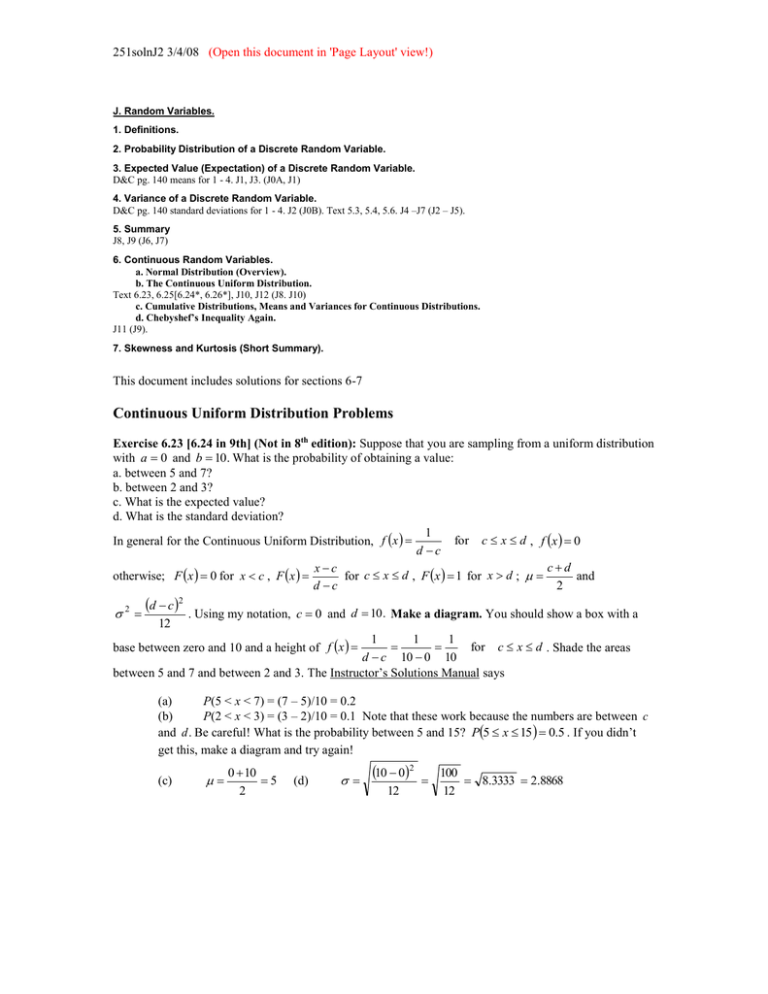Document 15930017
advertisement

251solnJ2 3/4/08 (Open this document in 'Page Layout' view!) J. Random Variables. 1. Definitions. 2. Probability Distribution of a Discrete Random Variable. 3. Expected Value (Expectation) of a Discrete Random Variable. D&C pg. 140 means for 1 - 4. J1, J3. (J0A, J1) 4. Variance of a Discrete Random Variable. D&C pg. 140 standard deviations for 1 - 4. J2 (J0B). Text 5.3, 5.4, 5.6. J4 –J7 (J2 – J5). 5. Summary J8, J9 (J6, J7) 6. Continuous Random Variables. a. Normal Distribution (Overview). b. The Continuous Uniform Distribution. Text 6.23, 6.25[6.24*, 6.26*], J10, J12 (J8. J10) c. Cumulative Distributions, Means and Variances for Continuous Distributions. d. Chebyshef’s Inequality Again. J11 (J9). 7. Skewness and Kurtosis (Short Summary). This document includes solutions for sections 6-7 Continuous Uniform Distribution Problems Exercise 6.23 [6.24 in 9th] (Not in 8th edition): Suppose that you are sampling from a uniform distribution with a 0 and b 10. What is the probability of obtaining a value: a. between 5 and 7? b. between 2 and 3? c. What is the expected value? d. What is the standard deviation? 1 for c x d , f x 0 In general for the Continuous Uniform Distribution, f x d c cd xc otherwise; F x 0 for x c , F x for c x d , F x 1 for x d ; and d c 2 2 d c 2 . Using my notation, 12 c 0 and d 10 . Make a diagram. You should show a box with a base between zero and 10 and a height of f x 1 1 1 for c x d . Shade the areas d c 10 0 10 between 5 and 7 and between 2 and 3. The Instructor’s Solutions Manual says (a) P(5 < x < 7) = (7 – 5)/10 = 0.2 (b) P(2 < x < 3) = (3 – 2)/10 = 0.1 Note that these work because the numbers are between c and d . Be careful! What is the probability between 5 and 15? P5 x 15 0.5 . If you didn’t get this, make a diagram and try again! (c) 0 10 5 2 (d) 10 02 12 100 8.3333 2.8868 12 251solnJ2 3/4/08 (Open this document in 'Page Layout' view!) Exercise 6.25 [6.26 in 9th] (Not in 8th edition): In a nuclear power plant seawater is used in cooling. The amount that the water temperature is raised has a continuous uniform distribution over the interval between 10 to 25 degrees Celsius. a. What is the probability that the temperature increase will be less than 20° C? b. What is the probability that the temperature increase will be between 10 and 22° C? c. Suppose that a temperature increase of more than 18° C is considered potentially dangerous? What is the probability that the temperature increase is potentially dangerous? d. What is the mean and expected value of the temperature increase? (a) P(10 < X < 20) = (20 – 10)/(25 – 10) = 0.6667 (b) P(20 < X < 22) = (22 – 20)/(25 – 10) = 0.1333 (c) P(18 < X < 25) = (25 –18)/(25 –10) = 0.4667 Note that (b) works because the numbers are between c and d . Be careful! (d) 10 25 17 .5 2 25 10 2 12 225 18 .75 4.3301 12 Problem J10 (Formerly J8): A component's life has a continuous uniform distribution between 15 and 25 days. (This means that it is extremely unlikely to die before the end of the 15 th day and will die before the end of the 25th day.) Find the following: a. The probability that it will last 21 days or more. b. The probability that it will last between 10 and 18 days. c. The probability that two such components both last between 18 and 20 days. d. The mean time that a component lasts. e. The variance of the duration of a component's life. f. The cumulative probability F 18 . Solution: In general for the Continuous Uniform Distribution, f x otherwise; F x 0 for x c , F x 2 d c 2 . 1 d c for c x d , f x 0 cd xc for c x d , F x 1 for x d ; and d c 2 12 For this particular component f x 0 for x 15 , f x 1 1 for 15 x 25 and f x 0 25 15 10 for x 25 . Make a diagram. Show a box with a height of 1 and a base between 15 and 25. 10 For a) shade the area inside the box between 21 and 25. For b) shade the area in the box between 15 and 18. (There is no area between 10 and 15.) For c) shade the area between 18 and 20. For f) shade the area between 18 and 25. 1 4 1 3 .4 .3 a) Px 21 25 21 b) P10 x 18 18 15 10 10 10 10 Make a diagram Make a diagram c) Here we must use the multiplication rule for independent events. Let event A be the event that component 1 lasts for 18 to 20 days and event B be the event that component 2 lasts for 18 to 22 days. 1 2 0.2 Then P A B P A PB . Since PB P A P18 x 22 22 18 10 10 P A B P A PB .2.2 .04 . d) In this distribution c 15 and d 25 , so e) The formula for the variance is 2 d c2 12 c d 15 25 20 . 2 2 25 15 2 100 8.33 12 12 251solnJ2 3/4/08 (Open this document in 'Page Layout' view!) f) F 18 Px 18 . The easiest way to do this problem is to make a diagram! However, there is a formula xc 18 15 3 .3 so F 18 Px 18 d c 25 15 10 Problem J12 (Formerly J10): Find P8 x 12 for the following distributions a. Continuous Uniform with c 3, d 27 (Make a diagram!). b. Continuous Uniform with c 3, d 10 (Make a diagram!). Find these areas in two ways. First, make an appropriate diagram and find the area of the box. Second, use the cumulative distribution to find P8 x 12 F 12 F 8 . Solution: a. P8 x 12 Continuous Uniform with c 3, d 27 . In the diagram below, shade the area between 8 and 12. that says F x 3 0 8 12 27 1 1 1 The height of the box is .04167 and the base of the shaded area is d c 27 3 24 12 8 1 12 – 8 = 4. So the area of the shaded area is P8 x 12 4 .1667 27 3 24 Another way to do a problem of this type is to remember that for any continuous distribution, we can use differences between cumulative distributions, Pa x b F b F a where the xc for c x d , cumulative distribution is F x0 Px x0 and F x d c F x 0 for x c and F x 1 for x d . 12 3 8 3 9 5 4 So P8 x 12 F 12 F 8 .1667 27 3 27 3 24 24 24 b. P8 x 12 Continuous Uniform with c 3, d 10 . In the diagram below, shade the area between 8 and 10 (since there is no area between 10 and 12). 0 3 8 10 12 1 1 1 .1429 and the base of the shaded area is The height of the box is d c 10 3 7 10 8 1 2 .2857 . 10 – 8 = 2. So the area of the box is P8 x 12 27 3 7 If we use the cumulative distribution method, remember F x 1 for x d . So P8 x 12 F 12 F 8 1 83 5 1 .2857 . 10 3 7 251solnJ2 3/4/08 (Open this document in 'Page Layout' view!) Tchebyschev Inequality Problems Problem J11 (Formerly J9): If x has the continuous uniform distribution between 10 and 25, show that the Chebyshef inequality is satisfied for 1, 2 and 3 standard deviations. How does this distribution compare with the Empirical Rule? Solution: Using the material above for k Tchebyschev says The Empirical Rule says 1 k 1 P x .68 P x 1 2 0 1 1 k 2 P 2 x 2 .95 P 2 x 2 1 2 .75 2 1 k 3 P 3 x 3 .997 P 3 x 3 1 2 .8889 3 c d 10 25 17 .5 and For the distribution described above c 10 and d 25 , and 2 2 d c2 25 10 2 15 2 225 18.75 . 18.75 4.330 f x 1 1 1 . 2 d c 25 10 15 12 12 12 12 So, for the values of k above: k 1 P x P17.5 4.33 x 17.5 4.33 P13.17 x 21.83 21 .83 13 .17 k 2 1 0.577 15 P 2 x 2 P17.5 2(4.33) x 17.5 2(4.33) P8.84 x 26.16 P10 x 25 1 P 3 x 3 P17.5 3(4.33) x 17.5 3(4.33) P4.51 x 30.49 P10 x 25 1 Make diagrams! Of course, these probabilities satisfy the Chebyshef relation, but undersatisfy the Empirical Rule in the first case and oversatisfy the Empirical Rule in the other two cases. k 3



